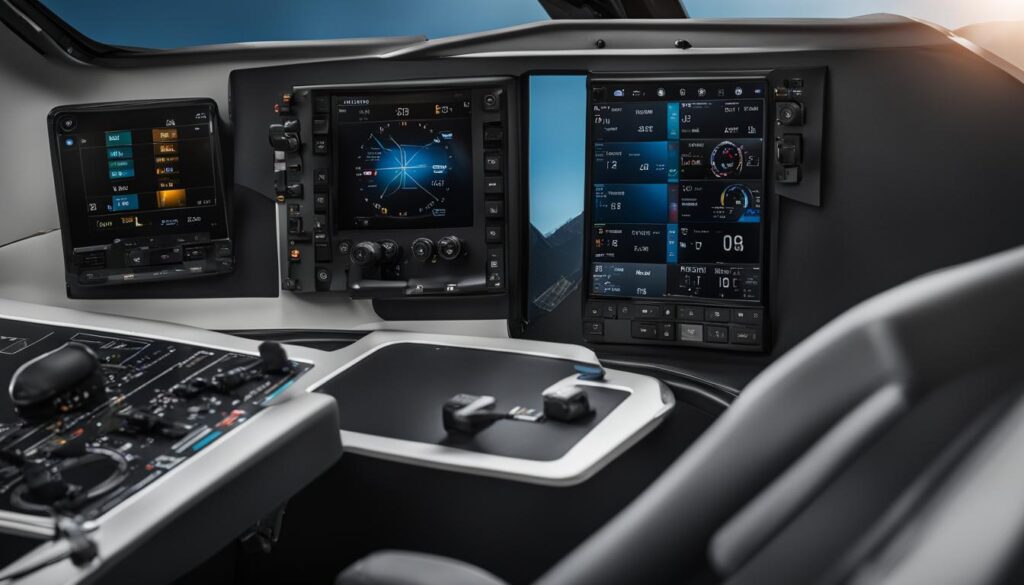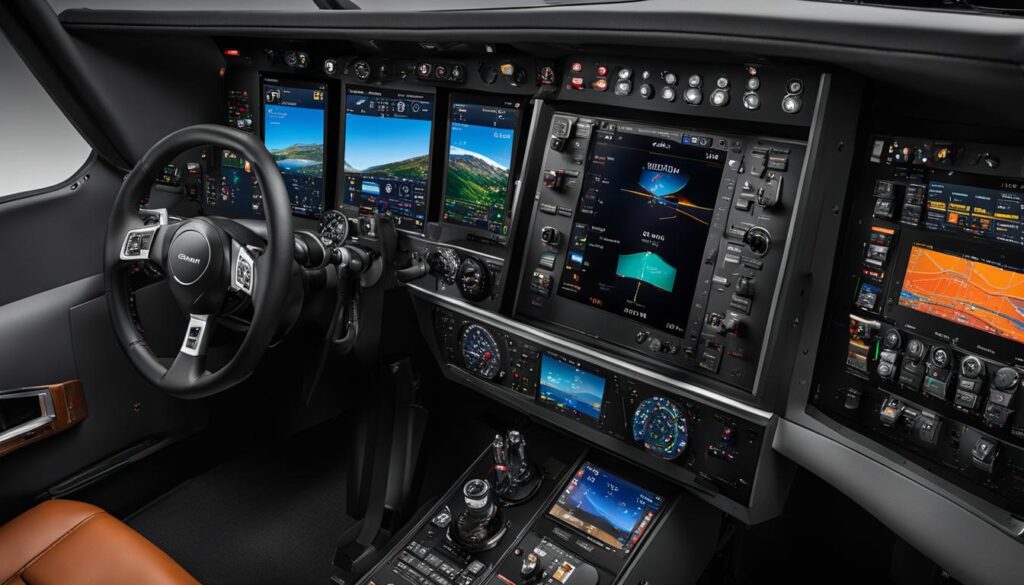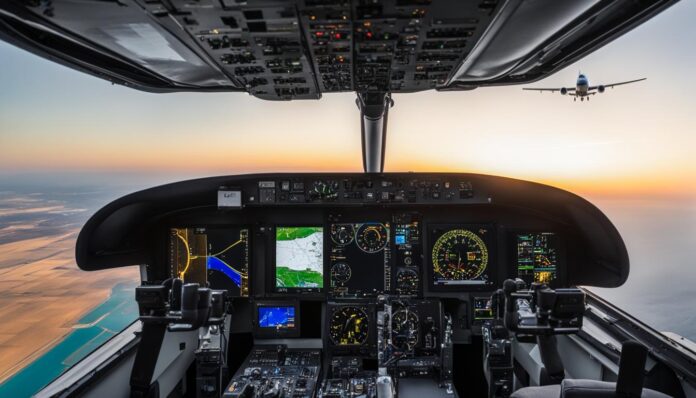As an Amazon Associate, I earn from qualifying purchases
When it comes to avionics systems for light turbine aircraft, Garmin Aviation has developed two popular options: the Garmin G1000 and the Garmin G3000. While both systems have their own unique features and capabilities, it’s important for pilots and aircraft owners to understand the differences between them and make an informed decision.
The G3000 is the newer of the two systems and boasts larger screens with better resolution compared to the G1000. It also offers a more modern user interface with touchscreen controls and intuitive menu structures. On the other hand, the G1000 has been in use for a longer time and is known for its reliability. It features a keypad for data entry and physical knobs for adjusting settings.
Key Takeaways:
- The Garmin G1000 and G3000 are avionics interface systems designed for light turbine aircraft.
- The G3000 features larger screens with better resolution and a more modern user interface.
- The G1000 has a proven track record of reliability and simplicity.
- The choice between the G1000 and G3000 depends on specific needs and preferences.
- Both systems offer a comprehensive set of features and functionality for informed cockpit decisions.
Features and Performance Comparison
When comparing the Garmin G1000 and G3000 avionics systems, it’s important to consider their features and performance capabilities.
The G3000 offers a three-screen touch suite, providing a larger display area and higher screen resolution compared to the G1000. This allows for enhanced clarity and improved visibility of critical flight information. The touchscreens also offer a user-friendly interface, making it easier for pilots to interact with the system.
Additionally, the G3000 features an aural confirmation system, which provides audio alerts and confirmations for various functions, enhancing situational awareness in the cockpit. It also offers advanced terrain and weather display capabilities, allowing pilots to better assess and navigate through challenging environmental conditions.
On the other hand, the G1000, while not as advanced as the G3000, still offers a comprehensive set of features. It includes synthetic vision, providing a 3D representation of the environment to aid in navigation. The G1000 also includes terrain awareness, alerting pilots to potential conflicts with the surrounding terrain, and traffic information, allowing for improved awareness of nearby aircraft.
The G3000 offers larger screens, higher resolution, and advanced features like aural confirmation and advanced terrain and weather display capabilities. The G1000, although not as advanced, still offers a reliable set of features including synthetic vision, terrain awareness, and traffic information.
It’s worth noting that the G1000 has a proven track record and is widely used in light aircraft. Its reliability and familiarity make it a popular choice among pilots, although it may not offer the same level of advanced features as the G3000.
Comparison
Here is a comparison of some key features of the Garmin G1000 and G3000:
| Features | Garmin G1000 | Garmin G3000 |
|---|---|---|
| Display Screens | One or two screens | Three large touchscreens |
| Screen Resolution | Lower resolution | Higher resolution |
| Aural Confirmation | No | Yes |
| Terrain Display | Yes | Advanced terrain display |
| Weather Display | Basic weather information | Advanced weather display |
Overall, while the G3000 offers more advanced features and a larger, higher resolution display, the G1000 still provides a reliable and comprehensive avionics system that meets the needs of many pilots.
User Interface and Functionality
When it comes to user interface and functionality, the Garmin G3000 and G1000 have distinct differences. The G3000 boasts a touchscreen interface with icon-driven controls, enhancing the efficiency of data entry and menu navigation. On the other hand, the G1000 relies on a traditional keypad and physical knobs for input.
Both systems offer a comprehensive range of functionality, including flight planning, navigation, and system monitoring. The G3000, with its advanced features, stands out by incorporating automatic emergency landing capabilities. Meanwhile, pilots value the G1000 for its reliability and ease of use.

Comparison of Garmin G1000 vs G3000 Functionality
| G3000 | G1000 | |
|---|---|---|
| Touchscreen Interface | Yes | No |
| Icon-driven Controls | Yes | No |
| Keypad | No | Yes |
| Physical Knobs | No | Yes |
| Flight Planning | Yes | Yes |
| Navigation | Yes | Yes |
| System Monitoring | Yes | Yes |
| Automatic Emergency Landing | Yes | No |
The G3000’s touchscreen interface and icon-driven controls offer a modern and intuitive experience, streamlining the pilot’s interaction with the system. On the other hand, the G1000’s reliance on a keypad and physical knobs provides a familiar and tactile approach. Both systems cater to the needs of pilots with their range of functionality, allowing for effective flight planning, navigation, and system monitoring.
While the G3000 stands out with its advanced features such as automatic emergency landing, the G1000’s reputation for reliability and user-friendly design continues to make it a popular choice among pilots.
Applications and Compatibility
The Garmin G3000 and G1000 avionics systems are designed to be compatible with a wide range of aircraft models, making them versatile choices for pilots. Whether you’re flying a larger turboprop or a smaller aircraft, both systems offer a range of applications and seamless integration.
G3000 Applications:
The G3000 is commonly found in advanced turboprops and light jets, providing cutting-edge avionics capabilities. This system can be found in popular aircraft models such as:
- Piper M600
- Daher TBM930
- Cessna CJ+ series
- Cirrus Vision Jet
G1000 Applications:
The G1000, on the other hand, is commonly used in smaller aircraft that require reliable and efficient avionics systems. Some of the aircraft models that feature the G1000 include:
- Cessna 172
- Cirrus SR20/22
Both the G3000 and G1000 systems are compatible with other avionics and can be seamlessly integrated with various aircraft systems and interfaces. This compatibility allows pilots to customize their avionics setup to suit their specific needs and preferences.
Advantages and Disadvantages
When comparing the Garmin G1000 and G3000 avionics systems, it’s important to consider the advantages and disadvantages of each. While the G3000 offers advanced features and a more modern user interface, the G1000 has its own strengths that make it a reliable choice for pilots.
Advantages of the Garmin G3000
- Advanced Features: The G3000 boasts a range of advanced features, including larger screens and higher resolution, providing a more immersive and detailed display.
- Modern User Interface: With its touchscreen controls and intuitive menu structures, the G3000 offers a more user-friendly and efficient interface.
- Integration: The G3000 seamlessly integrates with other systems and offers extensive functionality, making it suitable for newer aircraft models.
Disadvantages of the Garmin G3000
- Complexity: The advanced nature of the G3000 means that it can be more complex to operate, requiring additional training and familiarization.
- Learning Curve: Pilots transitioning from the G1000 to the G3000 may experience a learning curve due to the differences in interface and functionality.
Advantages of the Garmin G1000
- Reliability: The G1000 has a proven track record and is trusted by pilots for its reliability and performance.
- Simplicity: With its keypad and physical knobs, the G1000 offers a simpler user interface that many pilots find familiar and easy to use.
- Comprehensive Avionics: Despite not being as advanced as the G3000, the G1000 still provides a comprehensive set of avionics capabilities.
In summary, the G3000 offers advanced features and a more modern user interface, making it an attractive choice for newer aircraft models. However, it requires additional training and may be more complex to operate. On the other hand, the G1000 is known for its reliability and simplicity, making it a popular choice among pilots. Ultimately, the choice between the G3000 and G1000 depends on individual preferences, aircraft requirements, and the need for advanced features.
Performance and Functionality in Specific Models
When it comes to performance and functionality, the Garmin G3000 and G1000 avionics systems have distinct offerings tailored for different aircraft models. Let’s take a closer look at their capabilities in specific applications.
Piper M600
The Piper M600 is equipped with the state-of-the-art Garmin G3000 avionics suite. This system provides advanced performance and functionality, including integrated flight deck capabilities, high-resolution displays, and intuitive touchscreen controls.
Cessna CJ3+/M2
The Garmin G3000 avionics system is also utilized in the Cessna CJ3+ and M2 models. With its advanced features and specifications, including a three-screen touch suite and high-resolution displays, it offers enhanced performance and functionality for these aircraft.
Cirrus Vision SF50
The Cirrus Vision SF50 jet leverages the advanced capabilities of the Garmin G3000 avionics system. Pilots can experience seamless integration, advanced flight planning, and intuitive touchscreen controls, ensuring superior performance and functionality in this aircraft.
Daher TBM 930/TBM 940
The Daher TBM 930 and TBM 940 models are equipped with the Garmin G3000 avionics suite, delivering advanced performance, functional capabilities, and a comprehensive selection of features. The G3000 system enhances the performance and safety of these turboprop aircraft.
Cessna 172 and Cirrus SR20/22
Smaller aircraft, such as the Cessna 172 and Cirrus SR20/22, commonly feature the Garmin G1000 avionics system. While offering reliable performance and functionality suitable for these aircraft types, the G1000 ensures pilots have access to essential navigation, system monitoring, and flight planning capabilities.
By tailoring their avionics systems to specific aircraft models, Garmin ensures that pilots can enjoy optimized performance, advanced functionality, and a seamless user experience across a range of platforms.

Stay tuned for the next section where we delve into the customer experience and feedback surrounding the Garmin G3000 and G1000 systems.
Customer Experience and Feedback
Customer feedback plays a crucial role in evaluating the performance and usability of avionics systems such as the Garmin G3000 and G1000. Pilots who have experienced both systems generally express positive impressions. The advanced features and capabilities of the G3000, accompanied by its intuitive touchscreen interface, are highly appreciated.
The G1000, on the other hand, has gained a noteworthy reputation for its reliability and ease of use, making it a popular choice among pilots. While the G3000 offers a modern user interface, some users may still prefer the physical knobs and buttons of the G1000 for certain functions.
“The G3000 is a technologically advanced avionics system that enhances situational awareness and simplifies navigation. Its touchscreen interface revolutionizes the way we interact with the system. However, there are instances where the physical knobs and buttons of the G1000 are more practical.” – Captain David Wilson, experienced pilot
Customer Feedback Comparison
| Garmin G3000 | Garmin G1000 |
|---|---|
| Advanced features | Reliable and user-friendly |
| Intuitive touchscreen interface | Physical knobs and buttons preferred by some |
| Positive pilot experiences | Positive pilot experiences |
| High level of satisfaction | High level of satisfaction |
While the G3000 impresses pilots with its modern design and advanced capabilities, the G1000’s track record for reliability and ease of use solidifies its position as a trusted avionics system. Ultimately, customer experience and feedback provide valuable insights for pilots considering the best avionics solution for their specific needs and preferences.
Conclusion
In conclusion, when comparing the Garmin G1000 and G3000 avionics systems, it is clear that both offer advanced features and capabilities. The G3000, with its larger screens, higher resolution, and modern user interface, is the preferred choice for newer aircraft models. Its intuitive touchscreen controls and comprehensive functionality make it a top contender in the market.
On the other hand, the G1000 has stood the test of time with its proven track record, reliability, and simplicity. Pilots appreciate its user-friendly interface, which includes physical knobs and buttons for easy navigation. The G1000 continues to be a popular choice, particularly in smaller aircraft.
Ultimately, the decision between the G3000 and G1000 will depend on the specific needs and preferences of the pilot, as well as the aircraft model. Whether opting for the advanced capabilities of the G3000 or the trusted reliability of the G1000, both systems offer a comprehensive set of features and functionality that enhance cockpit decision-making.
FAQ
How do the Garmin G3000 and G1000 avionics systems compare?
While the G3000 is a newer system, the G1000 has been in use for a longer time. The G3000 features larger screens with better resolution compared to the G1000. It also has a more modern user interface with touchscreen controls and intuitive menu structures. The G1000, on the other hand, has a keypad for data entry and physical knobs for adjusting settings.
What features and performance capabilities do the G3000 and G1000 offer?
The G3000 offers a three-screen touch suite with a larger display area and higher screen resolution. It has an aural confirmation system and advanced terrain and weather display capabilities. The G1000 offers a comprehensive set of features including synthetic vision, terrain awareness, and traffic information. Both systems offer flight planning, navigation, and system monitoring.
What are the major differences in user interface between the G3000 and G1000?
The G3000 features a touchscreen interface with icon-driven controls, making data entry and menu navigation more efficient. The G1000 relies on a keypad and physical knobs for input.
In which aircraft models are the G3000 and G1000 used?
The G3000 can be found in turboprops and light jets such as the Piper M600, Daher TBM930, Cessna CJ+ series, and Cirrus Vision Jet. The G1000 is commonly used in smaller aircraft such as the Cessna 172 and Cirrus SR20/22.
What are the advantages and disadvantages of the G3000 and G1000?
The G3000 offers advanced features, larger screens, and a more modern user interface, making it a top choice for newer aircraft models. It requires additional training and can be more complex to operate. The G1000, although not as advanced as the G3000, is widely used and trusted by pilots. It has a simpler user interface and is known for its reliability.
How do the G3000 and G1000 perform in specific aircraft models?
The G3000 is used in a range of aircraft including the Piper M600, Cessna CJ3+/M2, Cirrus Vision SF50, and Daher TBM 930/TBM 940. The G1000 is commonly found in smaller aircraft such as the Cessna 172 and Cirrus SR20/22.
What is the customer experience and feedback on the G3000 and G1000?
Customer feedback on both the G3000 and G1000 has been generally positive. Pilots appreciate the advanced features and capabilities of the G3000, as well as its intuitive touchscreen interface. The G1000 has a reputation for reliability and ease of use.
What are the key differences between the G3000 and G1000 in terms of functionality?
The G3000 offers more advanced features such as automatic emergency landing, while the G1000 lacks some of these advanced capabilities. However, the G1000 still offers a comprehensive set of avionics capabilities.
